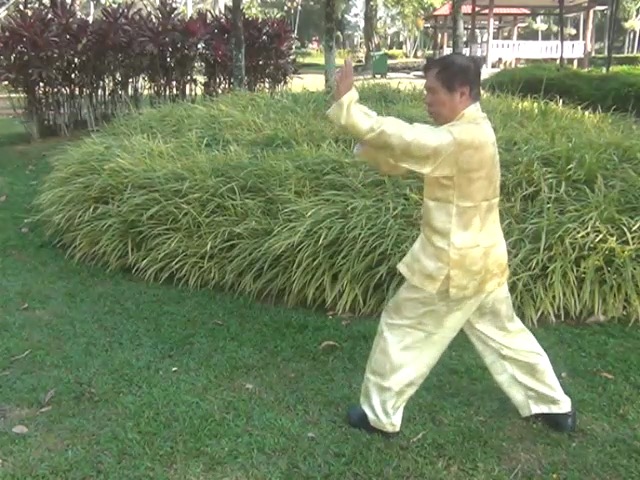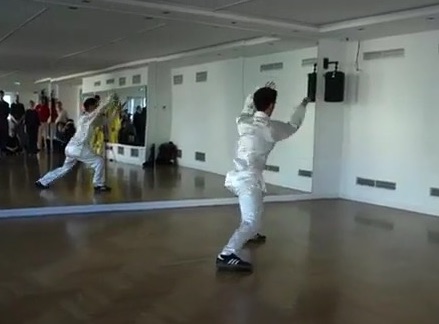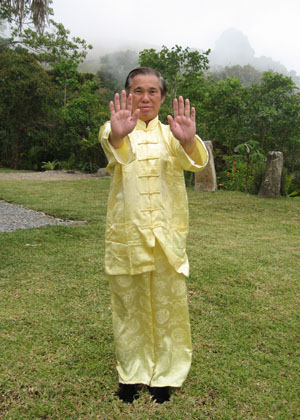SELECTION OF QUESTIONS AND ANSWERS
JUNE 2020 PART 2

Sifu Matt Fenton breaking the bottom brick with Cosmos Palm
Question 1
Would Cosmos Palm training be any different for a kungfu practitioner with a focus on using Cosmos Palm for combat vs a doctor/massage/healing practitioner with a focus on using Cosmos Palm for healing? Would any aspect of the training be emphasized for either approach?
At what point is it fair to say that one has attained Cosmos Palm?
— Sifu Matt Fenton, Shaolin Wahnam USA
Answer
Cosmos Palm is for combat. If all other things were equal, a Cosmos Palm master can heel better if he also knows healing. If he does not know healing, he should not attempt to heal.
The emphasis of combat is to consolidate energy, whereas the emphasis of healing is to let energy flow. Hence, a kungfu practitioner training Cosmos Palm for combat will focus on consolidating energy, and a doctor or a healer of any kind will focus on letting energy flow. The training methods are the same, the difference lies in emphasis or focus.
You have attained Cosmos Palm when you can do what a Cosmos Palm master does. A usual test of Cosmos Palm is to break the bottom of two bricks one on top of the other. You did that very well in New Hampshire, and the brick you used was very hard.
The signature sign of Cosmos Palm is the palm is red but tender. Hence it is often called Red-Sand Palm. We call it Cosmos Palm because the energy is derived from the Cosmos.
Some people try to train Cosmos Palm from books, like classics. Classics only mention the core instruction, leaving out what Cosmos Palm practitioners should know. For example, a classic may just mention "strike a stone with force". Someone learning from the writing will harm himself.
Question 2
When testing Cosmos Palm using a candle, how can a practitioner be sure that internal force is extinguishing the candle, and not just the wind caused by the moving hand?
Answer
A usual way is to ensure that the wind is not blowing.
A practitioner may feel the force flowing along his arm. Nevertheless, if he has been practicing kungfu, not necessary Cosmos Palm, for some time, his chi flow may have become natural that he may not feel it.
Another way is to place the candle in a cup or behind a sheet of glass. This is of a much higher level.

Z-Character Butterfly Palm
Question 3
When using Cosmos Palm for combat, does a practitioner need to have a specific thought or intention?
Answer
The practitioner does not need any specific thought or intention. As the energy of Cosmos Palm is "alive", further training does not merely improve his Cosmos Palm, but improve every aspect of his kungfu, and every aspect of his daily life.
If he uses thought or intention for any particular reason, the injury will be more severe.
I remember that many years ago I did an experiment in Lisbon. It was not with Cosmos Palm but with One-Finger Zen, but the philosophy is the same.
I lined up 7 persons in a row. I stood in front of the first person and pointed a finger at him. I wanted my force to pass through the first 5 persons without hurting them, and hit the 6th person.
The 6th person is Sifu Luis of Shaolin Wahnam Portugal. He was bounced away. His bouncing away also caused the 7th person to bounce away. I could not remember the name of 7th person or his reason for bouncing away, whether it was because of the bouncing away of the 6th person, or because he was also hit.
I had to give a chi flow, which would wash away the injury, to the 6th and the 7th persons. After the chi flow, Sifu Luis told us it was like a sharp knife piercing his heart.
Question 4
Is a knowledge of traditional Chinese medicine required to use Cosmos Palm for healing?
Can a practitioner accidentally cause harm when trying to use Cosmos Palm for healing without specific training in how to do the healing?
Answer
It is required that a healer must know traditional Chinese medicine or any medicine or healing. He must know what he is doing. If he has no knowledge he should not attempt the healing, even when he has Cosmos Palm.
In theory accidents can happen; but in practice, if a healer knows what he is doing, accidents would not happen.
Accidents are likely to happen if a person who has Cosmos Palm but no knowledge of medicine. Even what he does is technically correct, he may transmit too much energy.
Editorial Note:
Sifu Matt Fenton's questions can be found at May 2020 Part 3 and June 2020 Part 1.

Sifu Leonard Lackinger demonstrating "Spiritual Dragon Rises to Heaven"
Question 5
What is the application for "Spiritual Dragon Rises to Heaven"? It seems similar to "Fierce Tiger Descend Mountain", but without leaning forward. The Dragon Claw is usually used to grip, but in this pattern it seems more like poking to the face or eyes.
— Sifu Leonard Lackinger, Shaolin Wahnam Wien
Answer
In the Dragon Strength Set (Pattern 146) I made a mistake in labelling "Spiritual Dragon Rises to Heaven". It should be "Z-Character Butterfly Palm" in Bow-Arrow Stance. (The mistake has been rectified.)
There are two versions of "Z-Character Butterfly Palm" -- one in Unicorn Step, and the other, while shooting out the palms, in Bow-Arrow Stance. The third pattern, still in Bow-Arrow Stance, is deflecting an opponent's attack.
"Spiritual Dragon Rises to Heaven" and "Fierce Tiger Descends Mountain" are quite different. The former is used for lifting, while the latter is used for tearing. "Z-Character Butterfly Palm" is for deflecting, then shooting out the palm strikes. Of course you can also use the pattern for poking to the face or the eyes of an opponent.
I remember when a three-time Muay Thai champion challenged my sifu, my sifu used "Spiritual Dragon Rises to Heaven" to lift up the Muay Thai champion and threw him out of a door. When I asked my sifu that he must use a lot of strength to lift up the champion, he replied that he didn't need much strength as he used waist rotation.
In "Fierce Tiger Descends Mountain", one hand is used to grip an opponent's hand, and the other hand is used to tear at his face.
Question 6
I'm currently building up Pushing Mountains for Cosmos Palm training. When would be a good point to change from Wuji Stance to Horse-Riding Stance? Only after reaching 300 repetitions?
Answer
When you can perform "Pushing Mountains" comfortably at the Wuji Stance, you can change to the Horse-Riding Stance.
300 repetitions are quite a lot. You can change to 50 repetitions.
It is not the number of repetitions that is important. It is how you perform "Pushing Mountains'. You must let chi flow along your arms. One may perform 300 repetitions leisurely, but performing 50 repetitions with flowing chi is quite a feat.

Pushing Mountains
Question 7
Should I keep the 300 repetitions in Horse-Riding Stance as well? It's hard to imagine making 300 repetitions in Horse-Riding Stance, as it is so powerful and it takes about half an hour.
Answer
You can keep the 300 repetitions of "Pushing Mountains", or any pattern, in Horse-Riding Stance
Horse-Riding Stance is very powerful, but you do not go to 300 repetitions straight-away. You do so gradually. By the time you reach 300 repetitions, you are very powerful. Gradually you may not feel anything, but the power is there. Relatively, using the Wuji Stance is to let energy flow; using the Horse-Riding Stance is to consolidate the energy.
If you can perform 50 repetitions, your arms are powerful -- enough to break the arms of an ordinary person. The method to let energy flow and to consolidate the energy is more powerful than hitting a wooden dummy. As a rough estimate, it is more than 3 times more powerful.
I hit a wooden dummy every night when I trained with Uncle Righteousness. My arms were powerful. But later when I knocked-hand with my classmates in Sifu Chee Kim Thong's class, I was literally nowhere.
More significantly, the internal force derived from letting your energy flow, then consolidating it, makes your force "alive". Your internal force can flow anywhere. For example, you will attain peak performance in your daily work.
On the other hand, hitting a wooden dummy makes your force "dead". You only have powerful arms. It may not add to your health, vitality and longevity.
Question 8
When I reach the stage of "Forceful Big Windmill", is the "Forceful Big Windmill" done additionally to or instead of "Pushing Mountains"?
Answer
"Pushing Mountains" is for flowing force, and "Forceful Big Windmill" is for consolidating force. You need to have your force flowing before you consolidate it.
When your force is flowing well with "Pushing Mountains", you consolidate it with "Forceful Big Windmill". If you feel your force is not flowing, you can return to "Pushing Mountains".
Remember that kungfu is alive. Daily life is alive too. Guard against over-training. Your attainment is more than 10 times when I was a student.
LINKS
Selected Reading
- The Benefits of Cosmos Palm for Daily Life
- Dragon Strength, the Specialty of Grandmaster Wong
- Taijiquan Techniques against Knee Strikes
- Overcoming So Many Issues
- Scenic Architecture
